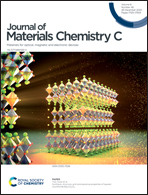Effect of thiophene/furan substitution on organic field effect transistor properties of arylthiadiazole based organic semiconductors†
Abstract
Four donor–acceptor (D–A) type organic semiconductors, consisting of 5-hexylthiophene with thiophene/furan flanked benzothiadiazole/naphthothiadiazole, were investigated for organic field effect transistor (OFET) application. Despite being an analogue of thiophene, furan has received less attention in organic electronics due to its dissimilar properties to thiophene and instability in photochemical oxidation. Nevertheless, this study determines that furan could display comparable charge transport properties to its analogue. The extension of the electron-accepting thiadiazole core with the benzo group and different heteroatom flanking groups were investigated to show that the performance of OFETs is dependent on the molecular orbital, geometry, and packing. Bottom-gate bottom-contact device configuration was used to study the OFET transport properties of all the molecules. We successfully proved that a furan unit is a promising building block with a mobility (μmax) of 0.0122 cm2 V−1 s−1 for devices employing furan-substituted benzothiadiazole as the channel layer.



 Please wait while we load your content...
Please wait while we load your content...